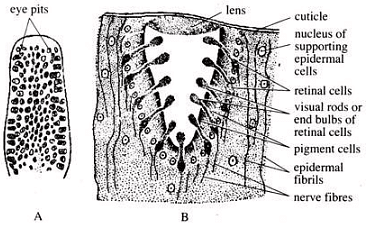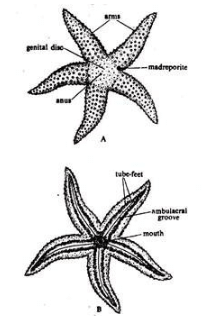UPSC Exam > UPSC Notes > Zoology Optional Notes for UPSC > Echinodermata: Asterias
Echinodermata: Asterias | Zoology Optional Notes for UPSC PDF Download
Asterias: The Common Starfish
Asterias, commonly known as "starfish" or "sea-stars," are intriguing, star-shaped echinoderms that roam freely in various oceans, inhabiting depths across the seas. These remarkable creatures come in vibrant colors, ranging from red, orange, blue, purple, to green, or even a blend of these hues. In the Andaman region, you can find purple and pink starfish. The genus Asterias encompasses approximately 150 species, with significant ones being A. rubens, A. gibbosa, A. vulgaris, A. forbesi, A. amurensis, A. panceri, and more.
Etymology: Origin: Greek (Aster), meaning "star."
Habit and Habitat of Asterias
Asterias are widespread marine echinoderms that prefer life on the seafloor. They thrive on various types of seabeds but have a particular liking for rugged, rocky coastlines where they can discreetly hide and lead a somewhat indolent existence. These carnivorous beings predominantly feast on bivalves. Most Asterias species are photonegative and opt for shaded habitats, except for a few like Asterias rubens, A. gibbosa, and A. panceri, which exhibit a positive response to light.
Structure of Asterias
- Asterias possess a flattened body with a five-pointed star shape, comprising a central disc and five symmetrically arranged arms (or rays). These arms are broad at their bases and taper towards their tips, reaching lengths two to three times the diameter of the disc. The body exhibits radial symmetry and possesses two surfaces: the upper, convex aboral (abactinal) surface, and the lower, flat oral (actinal) side with lighter pigmentation.

- The central disc on the oral side features a five-rayed aperture known as the mouth or actinosome, surrounded by a membranous peristome and adorned with five groups of oral papillae. Each arm contains an ambulacral groove with two to three rows of movable calcareous ambulacral spines. The aboral side showcases numerous rows of stout spines supported by ossicles. Dermal pores are scattered between the ossicles on the aboral side.
- At the center of the aboral side, you can find a minute aperture known as the anus, while between the bases of two arms (bivium) lies the madreporite, a flat disc-like structure with radiating grooves. The body is studded with tiny, moveable structures called pedicellariae, each featuring a flexible stalk and three calcareous pieces (one basilar and two jaws or valves).
Integumentary System of Asterias
Asterias' body wall consists of a ciliated columnar epithelium, neurosensory cells, pigment cells, and gland cells. The gland cells come in two types: goblet or mucus gland cells, filled with a granular substance for protective mucous coating, and muriform gland cells with coarse granules. Beneath the nerve fibrils, the dermis contains endoskeletal ossicles and a system of canalicular haemal spaces. A delicate basement membrane separates the epidermis and dermis. The muscular layer comprises outer circular and inner longitudinal muscles, and the innermost layer is the coelomic epithelium.
Skeleton of Asterias
Asterias boasts a rigid body with both supporting and superficial skeletons. The supporting skeleton comprises deeper skeletal elements (ossicles) embedded in the dermis, while the superficial skeleton includes spines, warts, and tubercles borne on the deeper skeleton. The ossicles, which vary in shape, are connected by connective tissue. Notably, the oral ossicles surround the mouth, and each ambulacral groove is supported by double rows of ambulacral ossicles that articulate like an inverted 'V.' Lateral adambulacral ossicles flank the ambulacral ossicles and bear movable spines.
Section of Arm in Asterias
In a cross-section of an Asterias arm, you'll find:
- A dorsal wall resembling an arch and a ventral part shaped like an inverted 'V' (the ambulacral furrow), with the aboral side thicker than the oral side.
- Layers including the epidermis, dermis, muscular layer, and coelomic epithelium.
- Surface features like spines, tubercles, pedicellariae, and warts borne on the deeper skeletal elements.
- Deeper skeletal elements comprising ossicles, including ambulacral ossicles and lateral adambulacral ossicles with movable spines.
- Hollow outgrowths known as respiratory papulae.
- A coelomic cavity filled with coelomocytes.
- Tube feet along the ambulacral groove, each ending in a sucker.
- Sense organs at the tip of the ambulacral groove, including a minute red spot (the eye) and a median unpaired terminal tentacle (olfactory organ).
- The radial canal, lateral or podial canals, radial nerves, Lange's nerve, hypo-neural sinus, and a dividing septum with a radial haemal strand.
Body Cavity of Asterias
Asterias possesses a true coelom, originating from an enterocoelic process. The perivisceral coelom extends throughout the body, enveloping the alimentary canal and gonads. Several small coelomic cavities are present, including those housing the water vascular system, axial sinus, perihaemal cavities, and genital sinuses.
Digestive System of Asterias
Asterias' digestive system consists of a short, straight alimentary canal and digestive glands, which play a crucial role in their nutrition.
Respiration in Asterias
- Respiratory Adaptations: Asterias has evolved a unique respiratory system. This system predominantly relies on delicate dermal papulae, which are specialized structures for gas exchange. These papulae are simple, transparent, contractile, and hollow outgrowths extending between the dermal ossicles. They are particularly abundant on the aboral side of the body.
- Histological Structure of Papulae: The histological structure of these papulae closely resembles that of the body wall. However, the dermis in papulae is thinner, and they entirely lack dermal skeleton. The lumen of each papula is continuous with the coelom and is lined by ciliated coelomic epithelium.
- Gas Exchange through Papulae: Respiration in Asterias occurs via the exchange of oxygen and carbon dioxide through these respiratory papulae by diffusion. While papulae play a significant role, the water vascular system, present throughout the body, also contributes to respiration. In some starfish, such as Asterias rubens, tube feet are responsible for approximately 10% of total oxygen uptake.
The Water Vascular System of Asterias
- The Hydraulic Powerhouse: The water vascular system stands out as a remarkable and defining feature within echinoderms. In Asterias, it plays a multitude of vital roles. This hydraulic system starts with the madreporite, a round calcareous plate on the aboral surface, marked by a unique inter-radial disposition. The madreporite features furrows with numerous pores at the bottom, each leading to a pore canal.

- A Complex Network: With around two hundred pores and pore canals, the water vascular system forms collecting canals, ultimately opening into the madreporic ampulla. This ampulla takes the form of an 'S'-shaped cylindrical madreporic or stone canal, characterized by calcareous rings supporting its walls.
- Tiedemann's Bodies and Unique Variations: Notably, the stone canal is linked to a series of other structures. It connects to the madreporite and axial sinus, where certain starfish exhibit pear-shaped sacs called polian vesicles. However, in Asterias, these vesicles are notably absent. Instead, the ring canal gives rise to nine small, spherical, glandular structures known as Tiedemann's bodies.
- Mysteries and Theories: The specific function of Tiedemann's bodies remains a subject of inquiry. While their exact role is not entirely understood, some researchers propose that these structures could be akin to lymphatic glands, possibly manufacturing amoebocytes for the water vascular fluid.
- Further Complexity: As the water vascular system extends throughout the starfish's body, it exhibits intricate connections with the haemal system, forming a complex network of canals and structures, including the stone canal, axial sinus, and axial organ.
Locomotion Mechanisms in Asterias
- Tube Feet Powering Movement: Asterias, in all its starry elegance, relies primarily on the action of tube feet for locomotion. These tube feet are central to the starfish's water vascular system, which operates on the principle of hydraulic pressure, indirectly influencing their mobility.
The Unique Haemal System of Asterias
Absence of a Traditional Blood Lacunar System
In Asterias, the traditional blood lacunar system is conspicuously absent. Instead, this function is undertaken by a distinct system called the haemal system. The haemal system consists of channels enclosed by coelomic spaces, representing a unique departure from conventional invertebrate circulatory systems.
The Fascinating Axial Complex in Asterias
- Complex Role in Starfish Physiology: Asterias boasts a well-developed axial complex, a pivotal structure in the starfish's internal organization. This complex consists of a coelomic cavity enveloping the stone canal and axial gland. This structure remains intricately linked to the inter-brachial septum, contributing to several physiological processes.
- The Axial Sinus and Its Functions: The axial sinus, a thin-walled tubular cavity, forms a critical part of the haemal system, connecting to the stone canal and eventually leading to the ampulla of the stone canal. The axial gland, a long spongy body with a distinct coloration, plays a role in starfish physiology and occupies a unique position within the axial complex.
Excretion in Asterias
- Excretion Process: Asterias possesses no specialized excretory organ. Instead, the role of excretion is taken up by the coelomocytes, multifunctional cells within the coelomic fluid. These cells are responsible for eliminating waste products from the coelomic fluid, primarily involving nitrogenous waste.
- Waste Product Disposal: Waste products, including ammonia, urea, and traces of uric acid, diffuse into the coelomic fluid. The coelomocytes, highly phagocytic cells, absorb these nitrogenous waste products and subsequently facilitate their removal from the body through the respiratory papulae. Of note, Asterias displays the unique presence of creatin and creatinine, compounds not commonly found in other invertebrates.
The Modest Nervous System of Asterias
A Simplified Neural Network
Asterias possesses a relatively simple and primitive nervous system, characterized by a diffuse nerve net without central ganglionic formations. The nervous system is distributed across three major systems: the oral or ectoneural system, the deep or hypo-neural system, and the coelomic nervous system.
Sense Organs in Asterias
- Limited Sensory Apparatus: The sensory capacities in Asterias are relatively undeveloped. However, the starfish does have a set of sensory structures that contribute to its perception of the environment. The main sensory components include neurosensory cells, terminal tentacles, and eyes.
- Neurosensory Cells: Scattered throughout the body surface, neurosensory cells play a key role in detecting external stimuli. These cells are particularly abundant in the tube feet, ambulacral regions, epidermis, and around pedicellariae and spines. Each neurosensory cell possesses a slender fusiform body, connecting proximally to the sub-epithelial nerve plexus and extending distally to the cuticle. These cells serve tactile and chemoreceptive functions.
- Terminal Tentacles: Terminal tentacles are considered tactile receptors. They aid in environmental exploration during locomotion, assisting the starfish in navigating its surroundings.
- Eyes: Starfish are equipped with simple, pigmented eyespots located at the tip of each arm on the oral side of the so-called terminal tentacle. The radial nerve cord extends to the base of these tentacles, terminating in sensory structures. These structures are often referred to as "eyes" and contain numerous pigmented ocelli or eye pits. Each ocellus is enclosed by a cuticle and features a transparent lens-like structure, enhancing vision. The pigmentation and organization of these eye structures are critical for the starfish's limited visual perception.
Reproduction in Asterias
Separate but Monomorphic Sexes
Asterias exhibits separate sexes but lacks sexual dimorphism, making it challenging to distinguish males from females based on external features.

Reproduction in Asterias primarily occurs sexually, with the potential for asexual reproduction through body fission.
The document Echinodermata: Asterias | Zoology Optional Notes for UPSC is a part of the UPSC Course Zoology Optional Notes for UPSC.
All you need of UPSC at this link: UPSC
|
181 videos|346 docs
|

|
Explore Courses for UPSC exam
|

|
Signup for Free!
Signup to see your scores go up within 7 days! Learn & Practice with 1000+ FREE Notes, Videos & Tests.
Related Searches


















